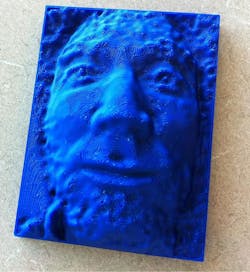99-cent iPhone app from Georgia Tech creates 3D optical scans, videos
Atlanta, GA--Yes, apparently there is an app for everything. Grant Schindler, a research scientist at Georgia Tech's College of Computing, has created an app for the latest iPhones and iPads that uses the devices' screen and camera to produce not only 3D optical scans, but also 3D videos. For a few dollars more, the app can be upgraded to export the scan data to computer-aided design (CAD) and other 3D programs.
Called Trimensional, the app relies on the iPhone screen as a variable-angle light, projecting four different lighting patterns on the subject while also using the device's front-facing camera to capture images. Software then produces a 3-D model that can be zoomed, rotated, and so on. While the technique has been around for more than twenty years, Schindler has eliminated the complexity (including an expensive lighting system) of previous setups.
"You can just have fun with it, or if you work with 3-D models, you can use it professionally," said Schindler.
The $5 "pro" upgrade for Trimensional is required to create an exportable data file.
Trimensional began as a program for a desktop computer in 2008, using the screen to light the subject. Georgia Tech's business incubator, the Advanced Technology Development Center, helped Schindler turn his idea into reality. The iPhone 4's front-facing camera made the app possible.
"Once we get scanners in everyone's hands, you should be able to use these images for any use you can think of, replicating physical objects by sending your scans to a 3-D printer, or creating a perfect digital substitute to take your video calls when you're not looking your best," said Schindler. "Or you could put it on your World of Warcraft character, or use it in other games."
Schindler is now working on a version for the Android operating system.
Source: Georgia Tech
Subscribe now to Laser Focus World magazine; it’s free!

John Wallace | Senior Technical Editor (1998-2022)
John Wallace was with Laser Focus World for nearly 25 years, retiring in late June 2022. He obtained a bachelor's degree in mechanical engineering and physics at Rutgers University and a master's in optical engineering at the University of Rochester. Before becoming an editor, John worked as an engineer at RCA, Exxon, Eastman Kodak, and GCA Corporation.
